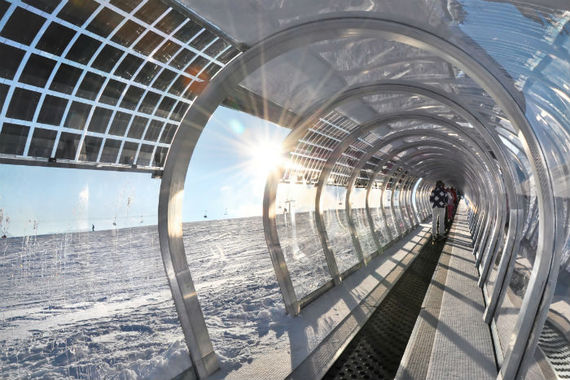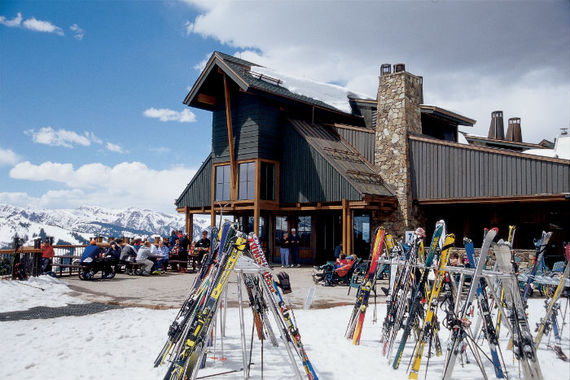There are a lot of misconceptions about the way ski resorts are portrayed in the environment. Ski resorts are often used as scapegoats-said to be the epitome of mankind's excess, the straw that broke the environment-camel's back.
But how true is that statement? There are a few things to consider:
1. Skiers, when they're skiing, actually produce LESS climate-changing CO2 than when they're back home in the city.
In order for them to operate cost effectively, ski resorts keep are always considering energy efficiency and clean energy. They want the resort to stay beautiful so people visit and because of this, they're much less likely to be damaging the environment than, well, every other place we humans live.
2. Studies have shown that using air conditioning systems burn up much more energy than when heating a very well-insulated ski resort building.
Not many other businesses sectors are spending tens of millions of dollars installing solar arrays, hydro plants and carbon capture facilities in order to fight climate change and make themselves carbon neutral, or carbon negative. And that's just the big ticket investments.
3. Skiers and ski resorts are the most likely to see and suffer from the effects of climate change than most other sectors.
Because of this, skiers and ski resorts are more likely to be proactive campaigners on the environment.

PHOTO: A ski lift that makes 70 percent more electricity than it consumes
With those things in mind, here are some of the world's greenest resorts.
Werfenweng, Austria
Most Austrian ski areas are fairly green but little Werfenweng goes a bit further. Home to the country's second largest photovoltaic solar power system, it is virtually self-sufficient, powering 260-buildings with this system. Werfenweng also endeavors to offer its guests the most climate-neutral holidays as possible. This includes the option for them to hand over their car keys on arrival (if arriving by train) and use the resort's taxi service or carbon-neutral vehicle rentals.
Another Austrian resort, Pitztal, aims to install another huge solar array this summer. With the cost of more than €2m, Pitztal aims to become fully solar powered.
Aspen Snowmass, Colorado
I've always had mixed feelings about Aspen. On one hand, you have an airport stacked with private jets, but on the other, you have one of the world's most environmentally pro-active ski areas. Aspen Skiing Company goes further than almost any other resort to minimize its CO2 emissions. The whole company has a green ethos running through it, and their specialized environmental management staff has been going above and beyond to cut climate change in every imaginable way -- along with plenty of other ways I previously never even thought of!
Aspen Skiing Company has now partnered with the Elk Creek coal mine, Holy Cross Energy and Vessels Coal Gas on a $5.5 million investment, in which waste methane vented from a coal mine in neighbouring Somerset, Colorado will be captured to generate carbon negative electricity. The power generated from this project will be able to produce as much energy as Aspen Skiing Company uses annually.
Les Gets, France
French ski area, Les Gets in the Portes du Soleil, has replaced diesel generators on ski lifts with solar panels. They are also recuperating kinetic energy on other chair lifts from the rotation of the return pulleys on the pylons.
On the mountain, the resort ensures that its snowmaking systems run without any additives and the piste-bashers use biodegradable diesel fuel. In the village, most buildings are heated by a biomass heating system that burns woodchip.
Les Gets is a member of the Alpine Pearls organization, which unites Alpine resorts in six countries with the common goal of environmental protection and promotion.
Whistler Blackcomb, Canada
It's hard for a resort that attracts a higher number of guests than most others on the planet to go green, but Whistler does it. The Fitzsimmons Creek Renewable Energy Project, lying in the valley below their record-breaking high Peak2Peak lift, produces enough power to match the total annual energy consumption at the famous resort.
Located entirely within Whistler Blackcomb's operating area, the run-of-river project produces 33 gigawatt hours of hydro electricity per year. That's the equivalent of powering the ski resort's winter and summer operations including around 40 lifts, 17 restaurants, 270 snowguns and countless other buildings and services.
Whistler Blackcomb, Canada
It's hard for a resort that attracts a higher number of guests than most others on the planet to go green, but Whistler does it. The Fitzsimmons Creek Renewable Energy Project, lying in the valley below their record-breaking high Peak2Peak lift, produces enough power to match the total annual energy consumption at the famous resort.
Located entirely within Whistler Blackcomb's operating area, the run-of-river project produces 33 gigawatt hours of hydro electricity per year. That's the equivalent of powering the ski resort's winter and summer operations including around 40 lifts, 17 restaurants, 270 snowguns and countless other buildings and services.
Jiminy Peak, Massachusetts
After three years of creative financing, studies and engineering challenges (dragging tons of cranes, blades, tower sections and a generator housing up a 2.3 mile road and 27 degree grade) the Jiminy Peak "Zephyr" wind turbine began producing power in summer 2007.
The resort's $3.9 million, 1.5 megawatt wind turbine uses three 123-ft. blades mounted to a 253ft (76m) tower. From blade-tip to ground, it's 386ft (116m) tall. Jiminy's wind turbine generates 4.6 million kWh (kilowatt hours) of energy per year -- about 33 percent of the resort's total electricity consumption.
"The turbine helps to protect the long-term viability of Jiminy Peak as a resort, and therefore helps to assure jobs better than being at the risk of changes in power prices," says a resort statement. "Perhaps more importantly is the impact of this wind turbine on our generation's grandchildren and great grandchildren in a country where we have too much dependency on fossil fuel for energy."
View Jiminy Peak lift tickets.
By Patrick Thorne / @Snowhoper

